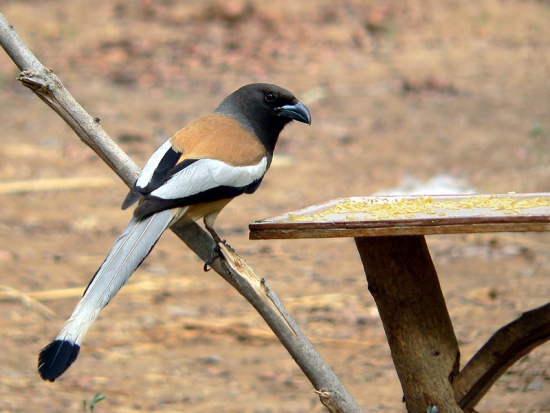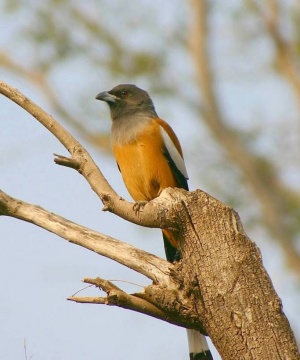m |
m |
||
| Line 38: | Line 38: | ||
A sedentary species. | A sedentary species. | ||
==References== | ==References== | ||
| − | # | + | #{{Ref-Clements6thDec09}}#{{Ref-HBWVol14}}#{{Ref-RasmussenAnderton05}} |
{{ref}} | {{ref}} | ||
==External Links== | ==External Links== | ||
{{GSearch|Dendrocitta+vagabunda}} | {{GSearch|Dendrocitta+vagabunda}} | ||
[[Category:Birds]] [[Category:Dendrocitta]] | [[Category:Birds]] [[Category:Dendrocitta]] | ||
Revision as of 09:41, 22 March 2010
Alternative name: Indian Treepie
- Dendrocitta vagabunda
Identification
46 - 50cm.
- Blackish hood and breast
- Large whitish panel on wings, black primaries
- Tawny brown underparts and lower back
- Ginger brown mantle
- Short, thick, downcurved black bill
- Long bluish-grey tail with a black band on the tip
- Rounded wings
Sexes similar. Juveniles have browner hood and back, a pale buff rump and underparts and a buff-tipped tail. They sometimes lack rufous tones.
Similar species
All other treepies have mainly black wings.
Distribution
Found from east Pakistan to India, Nepal, Bhutan, Burma, adjacent southern China (SW Yunnan), Thailand, Cambodia, south Laos and south and central Vietnam.
Generally common and widespread in its range. Localized in Vietnam.
Taxonomy
Although the geographical variation seems to be clinal nine subspecies are recognized:
- D. v. bristoli in Pakistan and northwest India
- D. v. vabagunda in most of India
- D. v. behni in west and central India
- D. v. parvula in southwest India
- D. v. palllida in southeast India
- D. v. sclateri in Burma
- D. v. kinneari in Burma, Yunnan and northwest Thailand
- D. v. saturatior in Burma and southwest Thailand
- D. v. sakeratensis in Thailand, Cambodia, Laos and Vietnam
Habitat
Open forest consisting of scrub, plantations and gardens. Also in city parks.
Mostly in lowlands but ascending as high as 2100m.
Behaviour
Omnivorous. It feeds on fruits, invertebrates, small reptiles and the eggs and young of birds.
Usually seen in pairs or family groups. Follows other species (like Woodpeckers) and may ride on backs of domestic and wild large mammals, feeding on ectoparasites.
Breeding season generally from March to July, depending to rains. The nest is a rather small flimsy cup made of twigs. It's placed 6 - 8m above the ground, often in an exposed and prominent tree. Lays 2 - 6 eggs.
A sedentary species.
References
- Clements, JF. 2009. The Clements Checklist of Birds of the World. 6th ed., with updates to December 2009. Ithaca: Cornell Univ. Press. ISBN 978-0801445019.
- Del Hoyo, J, A Elliott, and D Christie, eds. 2009. Handbook of the Birds of the World. Volume 14: Bush-shrikes to Old World Sparrows. Barcelona: Lynx Edicions. ISBN 978-8496553507
- Rasmussen, PC and JC Anderton. 2005. Birds of South Asia: The Ripley Guide. Barcelona: Lynx Edicions. ISBN 978-8487334672
Recommended Citation
- BirdForum Opus contributors. (2025) Rufous Treepie. In: BirdForum, the forum for wild birds and birding. Retrieved 28 April 2025 from https://www.birdforum.net/opus/Rufous_Treepie





